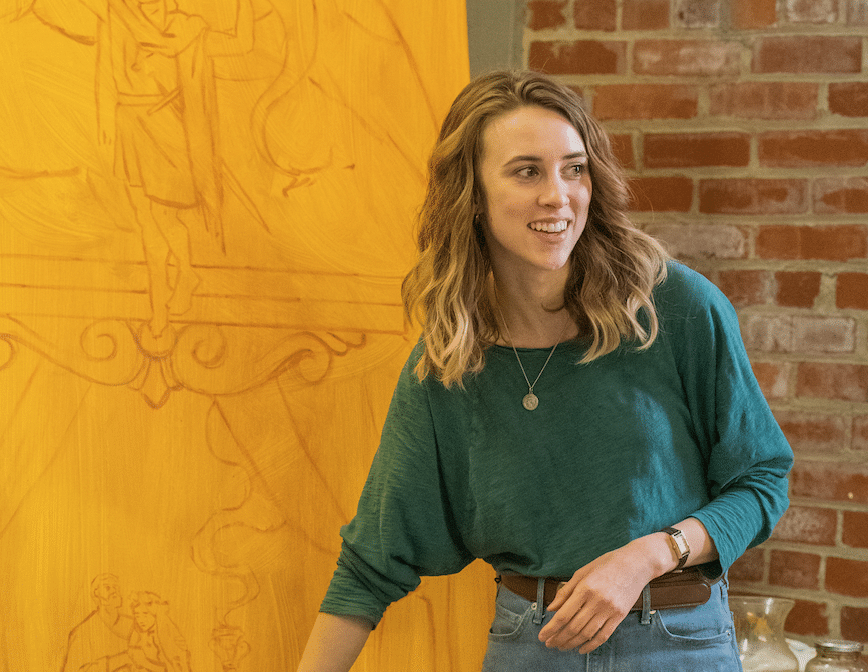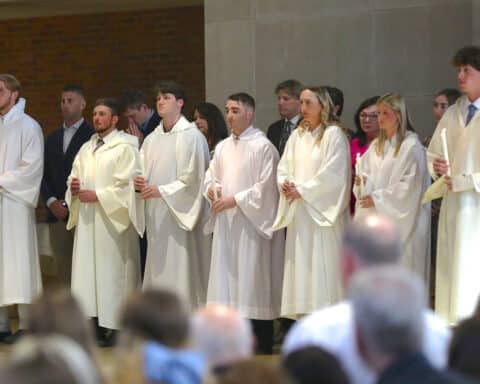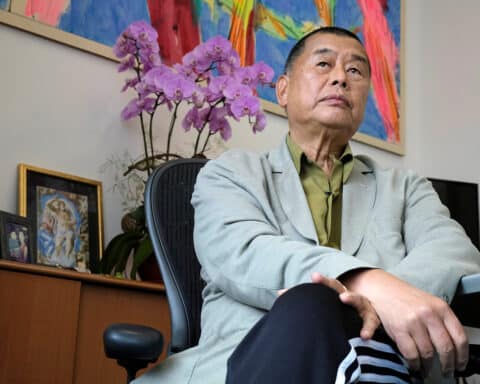Mattie Karr wanted to be an infiltrator. The 28-year-old Kansas native had big dreams of traveling to Hollywood and stealthily planting spiritual seeds in the work she did, smuggling religious themes into mainstream stories and animation.
“I loved the idea of being incognito with my art. I could be this Catholic evangelizing spy, almost,” she said.
It didn’t work out, and she is so glad.

First of all, she loves living in Kansas and loves the parish where she just finished a massive commission, three years in the making. It consists of two 15-foot high triptychs that bring color and warmth to either side the rather austere apse of Holy Name of Jesus in Kansas City. Second, she found that she couldn’t stop making religious art if she tried. “As I grew in my faith, I couldn’t help it. The art just came out and it was all religious, mostly Mary. I couldn’t stop drawing Mary,” she said. The big shift came when she went on retreat, and some people prophesied over her, saying that God was calling her to do something and that she needed to be brave and step out.
“It was very clear he wanted me to leap,” she said. A week later, she did, quitting her job in sales, and launching her full-time career as an artist. Karr paints and draws sacred and liturgical art and also does commissions with specific religious themes, depicting spiritual tableaux that are particularly meaningful to her patrons.
Surrendered sacred artist
Now that she’s surrendered to the idea of being a sacred artist, she said life has gotten so much easier.
“The images come a lot quicker. It doesn’t feel like as much of a struggle,” she said. “I appreciate wearing my religion on my sleeve in my business. It’s much more freeing.”
Karr said she once met a priest at a wedding, and he was adamant that she is an iconographer. Although Karr has done a painting that, at the request of a client, borrows some elements of traditional iconography, most of her work is in a very different mode. But the priest insisted, “Your spirituality is that of an icon painter. I can tell you pray through it.”
And this is so.
Awareness of the Holy Spirit
“Even if I’m not consciously praying, I’m praying,” she said. “Even in artist mode, I’m aware of the Holy Spirit.”
When she’s working with a client to develop a commissioned piece, she prays with them, and asks the Holy Spirit to give her an image for them. This is what happened when a client asked her to portray Mary, Undoer of Knots.
She collaborated with a client whose wife is a mental health counselor and had a recurring dream of Mary dressed in work clothes, diligently unbinding the tangles in a long ribbon that shines in the light falling on her shoulders.
Karr said that, although the image was made for one client, it often brings people to tears, even if they previously knew nothing of this traditional title of Mary.

“I’ve seen how much God can speak through these images. Beauty has this quality of stopping people in their tracks and making them pay attention,” she said. It breaks through the silence, even a silence we may not be aware of.
“So many people in their relationship with God don’t think he has much to say to them. Even devout Christians don’t experience the love of God in their lives,” she said. But sometimes beauty can speak to them with God’s voice.
“It’s a collaboration with the Holy Spirit. I’m always asking,” she said.
Sometimes that collaboration seems to come in the form of failure. When Karr was preparing a parishioner to pose for a painting of Mary, the bedsheet Karr was using as a stand-in for her mantle would not stay on the model’s head, no matter what they tried. Karr thought maybe they should just skip it.
She hesitated, though, not wanting to portray Mary disrespectfully; so she asked the pastor.
“Father Anthony said, ‘Well, actually, Jewish women only had their heads uncovered in front of family. And this is in the presence of the Holy Spirit.'”
They decided to work with the situation and take it as a cue to draw out something even deeper than they had planned: Mary’s relationship with and vulnerability before God.
It wasn’t the only time such an apparent coincidence caught Karr’s attention while she was planning the piece. She noticed the parishioner immediately, and admired her dark, lavish hair; but she didn’t know who she was. She went to the priest and said she had found someone for Mary. He was a little alarmed, because he, too, already had someone in mind.
It was the same woman — and her looks were only part of the story.
“She came in with her husband, and we dressed her up. It was very emotional to see her dress up as Mary,” Karr said. “A friend asked her what it means to her to portray Mary, and she said, ‘We lost our son to cancer 10 years ago. I know what it’s like to walk with a suffering son.'”
Karr said, “I was like, ‘Whoa. This isn’t mine. This project was utterly the Lord’s.'” She said she felt that, in her project, the Lord was ministering to this woman, and also to many others in the congregation. It’s a heavily Hispanic parish, and she said that the people in the pews are moved and touched to see a Holy Family that looks like them.
She also invited members of the parish to come and pose for the various figures in the crowd, giving them an unusual degree of ownership of the large images that decorate their church (although she sometimes deliberately combines elements of two or three faces, so the features are not readily recognizable as specific parishioners).
When art ministers
That painting ministered to her, as well.
“I had been painting the Baby Jesus at one point when things were not going well in my personal life,” she said. “I was upset, and I was painting his eye, and suddenly the painting was looking at me. The purity of who He is as a baby, looking at me, and loving me.”
That’s the first time that happened to her.
“I remember being really startled. It was the work of my hands loving me in return,” she said.
The Baby Jesus is the only figure in the two triptychs who looks out at the viewer, and she said that many people have expressed how striking it is to be captured by the gaze of that child.

That’s what Karr wants to do: To capture and help people see something true. Karr also teaches art to high school students part-time, and in addition to her sacred and liturgical work, she often does live paintings at weddings. She thinks the fashion of hiring a live painter speaks to people’s longing to know they, and the love they bear for their spouse is real and important.
“I don’t want it to look like a photograph. That’s where my illustration skill comes in. I’m creating a character and a story,” she said.
Slowing down
“We all want to capture the moment so badly nowadays. We’re all looking for meaning. All the photos we take, and this hyper-awareness of our image — painting has a way of slowing that down,” she said. “You have to decide what’s important, and what’s not important.”
After Karr, no longer trying to be incognito, climbs up on a ladder to add the finishing rays of light to her tryptichs and then climbs down again, she has several other long-term plans. One involves one of the ministries she works with, Living Waters, which offers help for sexual and relational brokenness. The program is rooted in John Paul II’s theology of the body. She’s illustrated one chapter of their 20-chapter guidebook and hopes to eventually do the rest.
She’s not in a hurry. She feels God is urging her to “slow down and take time to learn how to paint the body,” she said.
Karr found a book about figure drawing from the 1940s, and she’s slowly working her way through all the lessons, building her stamina and her skill.
“I’m going to take my time with it. It feels meaningful,” she said.





